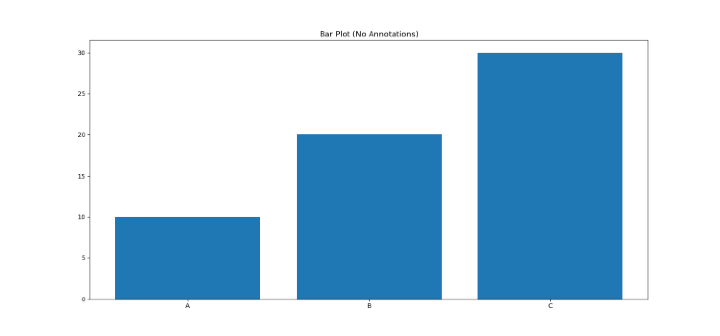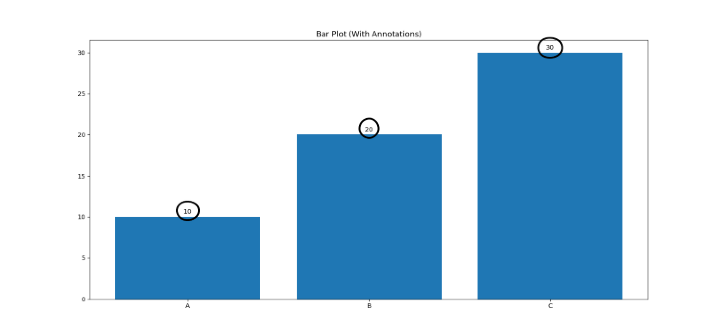 Backend Development
Backend Development
 Python Tutorial
Python Tutorial
 How to add annotations to bar plots in Python's Matplotlib?
How to add annotations to bar plots in Python's Matplotlib?
How to add annotations to bar plots in Python's Matplotlib?
Introduction
Bar chart is a commonly used chart in data visualization. They are the first choice of many data scientists because they are easy to generate and understand. However, when we need to visualize other information, bar charts may not be sufficient.
comments are useful in this case. In a bar chart, you can use annotations to better understand the data.
Grammar and Usage
Use Matplotlib's annotate() function. The method accepts many inputs, such as the text to be annotated, where the annotation should be placed, and several formatting choices, including font size, color, and style. The basic syntax of the annotate() function is as follows:
ax.annotate(text, xy, xytext=None, arrowprops=None, **kwargs)
text - The text string to display as a comment
xy - (x, y) coordinates of the point to annotate
xytext - The (x, y) coordinates of the text location. If not specified, xy will be used.
arrowprops - A dictionary of arrow properties such as color, width, style, etc.
**kwargs - Additional keyword arguments for styling the annotation text, such as font size, color, etc.


You can use the annotate() method to mark certain data points or add more information to the plot. Additionally, it can be used to generate graphical components such as arrows or other markers that indicate specific plot points.
To annotate the bars in a bar chart using Matplotlib, we can utilize this algorithm -
Import necessary libraries
Use plt.figure() to create a graphics object.
Use Fig.add_subplot() to add a subplot to the figure.
Use ax.bar() to create a bar chart.
Loop through the bars and add annotations using ax.annotate().
Pass the height, width and text to be displayed to the annotate() function
Use plt.show() to render graphics
Example
import matplotlib.pyplot as plt
# Create a figure object
fig = plt.figure()
# Add a subplot to the figure
ax = fig.add_subplot(111)
# Create the bar plot
bars = ax.bar(['A', 'B', 'C'], [10, 20, 30])
# Loop through the bars and add annotations
for bar in bars:
height = bar.get_height()
ax.annotate(f'{height}', xy=(bar.get_x() + bar.get_width() / 2, height), xytext=(0, 3),
textcoords="offset points", ha='center', va='bottom')
# Show the plot
plt.title('Bar Plot (With Annotations)')
plt.show()
First create a graphics object and attach a subgraph to it. Then, use the plt.bar() method to generate a bar chart and save the generated bar chart in a variable named bars. Loop through the bar chart and add annotations using the plt.annotate() method.
The first option is the text you want to annotate, in this case the height of the bar. The xy parameter is then used to indicate the position of the annotation, which is an (x, y) coordinate pair.
The xytext option is used to indicate the offset of the text relative to the xy coordinates. Finally, specify the horizontal and vertical alignment of the text using the ha and va options.
It’s worth noting that the plt.annotate() method gives you a number of options for customizing the annotations in the bar chart. You can design an annotation that exactly suits your personal needs by experimenting with different values for the xy, xytext, ha, and va variables.
in conclusion
You can add unique annotations to bar plots in Matplotlib to help interpret the data presented using the annotate() function. This article outlines a step-by-step algorithm that allows you to easily add this functionality to your own applications. Just follow the instructions and you can create useful and beautiful annotated bar charts.
The above is the detailed content of How to add annotations to bar plots in Python's Matplotlib?. For more information, please follow other related articles on the PHP Chinese website!

Hot AI Tools

Undresser.AI Undress
AI-powered app for creating realistic nude photos

AI Clothes Remover
Online AI tool for removing clothes from photos.

Undress AI Tool
Undress images for free

Clothoff.io
AI clothes remover

Video Face Swap
Swap faces in any video effortlessly with our completely free AI face swap tool!

Hot Article

Hot Tools

Notepad++7.3.1
Easy-to-use and free code editor

SublimeText3 Chinese version
Chinese version, very easy to use

Zend Studio 13.0.1
Powerful PHP integrated development environment

Dreamweaver CS6
Visual web development tools

SublimeText3 Mac version
God-level code editing software (SublimeText3)

Hot Topics
 1656
1656
 14
14
 1415
1415
 52
52
 1309
1309
 25
25
 1257
1257
 29
29
 1229
1229
 24
24
 PHP and Python: Different Paradigms Explained
Apr 18, 2025 am 12:26 AM
PHP and Python: Different Paradigms Explained
Apr 18, 2025 am 12:26 AM
PHP is mainly procedural programming, but also supports object-oriented programming (OOP); Python supports a variety of paradigms, including OOP, functional and procedural programming. PHP is suitable for web development, and Python is suitable for a variety of applications such as data analysis and machine learning.
 Choosing Between PHP and Python: A Guide
Apr 18, 2025 am 12:24 AM
Choosing Between PHP and Python: A Guide
Apr 18, 2025 am 12:24 AM
PHP is suitable for web development and rapid prototyping, and Python is suitable for data science and machine learning. 1.PHP is used for dynamic web development, with simple syntax and suitable for rapid development. 2. Python has concise syntax, is suitable for multiple fields, and has a strong library ecosystem.
 PHP and Python: A Deep Dive into Their History
Apr 18, 2025 am 12:25 AM
PHP and Python: A Deep Dive into Their History
Apr 18, 2025 am 12:25 AM
PHP originated in 1994 and was developed by RasmusLerdorf. It was originally used to track website visitors and gradually evolved into a server-side scripting language and was widely used in web development. Python was developed by Guidovan Rossum in the late 1980s and was first released in 1991. It emphasizes code readability and simplicity, and is suitable for scientific computing, data analysis and other fields.
 Python vs. JavaScript: The Learning Curve and Ease of Use
Apr 16, 2025 am 12:12 AM
Python vs. JavaScript: The Learning Curve and Ease of Use
Apr 16, 2025 am 12:12 AM
Python is more suitable for beginners, with a smooth learning curve and concise syntax; JavaScript is suitable for front-end development, with a steep learning curve and flexible syntax. 1. Python syntax is intuitive and suitable for data science and back-end development. 2. JavaScript is flexible and widely used in front-end and server-side programming.
 How to run sublime code python
Apr 16, 2025 am 08:48 AM
How to run sublime code python
Apr 16, 2025 am 08:48 AM
To run Python code in Sublime Text, you need to install the Python plug-in first, then create a .py file and write the code, and finally press Ctrl B to run the code, and the output will be displayed in the console.
 Can vs code run in Windows 8
Apr 15, 2025 pm 07:24 PM
Can vs code run in Windows 8
Apr 15, 2025 pm 07:24 PM
VS Code can run on Windows 8, but the experience may not be great. First make sure the system has been updated to the latest patch, then download the VS Code installation package that matches the system architecture and install it as prompted. After installation, be aware that some extensions may be incompatible with Windows 8 and need to look for alternative extensions or use newer Windows systems in a virtual machine. Install the necessary extensions to check whether they work properly. Although VS Code is feasible on Windows 8, it is recommended to upgrade to a newer Windows system for a better development experience and security.
 Where to write code in vscode
Apr 15, 2025 pm 09:54 PM
Where to write code in vscode
Apr 15, 2025 pm 09:54 PM
Writing code in Visual Studio Code (VSCode) is simple and easy to use. Just install VSCode, create a project, select a language, create a file, write code, save and run it. The advantages of VSCode include cross-platform, free and open source, powerful features, rich extensions, and lightweight and fast.
 How to run python with notepad
Apr 16, 2025 pm 07:33 PM
How to run python with notepad
Apr 16, 2025 pm 07:33 PM
Running Python code in Notepad requires the Python executable and NppExec plug-in to be installed. After installing Python and adding PATH to it, configure the command "python" and the parameter "{CURRENT_DIRECTORY}{FILE_NAME}" in the NppExec plug-in to run Python code in Notepad through the shortcut key "F6".



